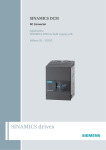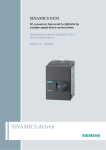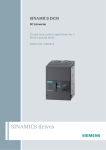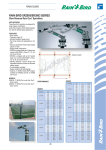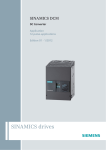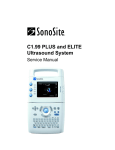Download Master-slave switchover application
Transcript
SINAMICS DCM DC converters from 6 kW to 2500 kW for variable-speed direct-current drives Master-slave switchover application Edition 01 - 03/2011 SINAMICS drives SINAMICS DCM Master-slave switchover application Compact User Manual Legal information Warning notice system This manual contains notices you have to observe in order to ensure your personal safety, as well as to prevent damage to property. The notices referring to your personal safety are highlighted in the manual by a safety alert symbol, notices referring only to property damage have no safety alert symbol. These notices shown below are graded according to the degree of danger. DANGER indicates that death or severe personal injury will result if proper precautions are not taken. WARNING indicates that death or severe personal injury may result if proper precautions are not taken. CAUTION with a safety alert symbol, indicates that minor personal injury can result if proper precautions are not taken. CAUTION without a safety alert symbol, indicates that property damage can result if proper precautions are not taken. NOTICE indicates that an unintended result or situation can occur if the corresponding information is not taken into account. If more than one degree of danger is present, the warning notice representing the highest degree of danger will be used. A notice warning of injury to persons with a safety alert symbol may also include a warning relating to property damage. Qualified Personnel The product/system described in this documentation may be operated only by personnel qualified for the specific task in accordance with the relevant documentation for the specific task, in particular its warning notices and safety instructions. Qualified personnel are those who, based on their training and experience, are capable of identifying risks and avoiding potential hazards when working with these products/systems. Proper use of Siemens products Note the following: WARNING Siemens products may only be used for the applications described in the catalog and in the relevant technical documentation. If products and components from other manufacturers are used, these must be recommended or approved by Siemens. Proper transport, storage, installation, assembly, commissioning, operation and maintenance are required to ensure that the products operate safely and without any problems. The permissible ambient conditions must be adhered to. The information in the relevant documentation must be observed. © Siemens Ⓟ2011 C98130-A7066-A503-01-7619, 03/2011 1 Table of contents 1 Instructions ............................................................................................................................................................. 3 2 Applications ............................................................................................................................................................ 3 3 Master-slave drives for rigidly coupled motors......................................................................................................... 4 3.1 Application .................................................................................................................................................................. 4 3.2 Recommended circuit................................................................................................................................................. 4 3.3 Parameter settings ..................................................................................................................................................... 5 3.4 Optimization runs........................................................................................................................................................ 6 4 Master-slave switchover.......................................................................................................................................... 7 4.1 Application .................................................................................................................................................................. 7 4.2 Recommended circuit................................................................................................................................................. 7 4.3 4.3.1 4.3.2 4.3.3 4.3.4 Version 1 .................................................................................................................................................................... 7 Operating mode of the master-slave drive.................................................................................................................. 7 Separate operation ..................................................................................................................................................... 7 Parameter settings ..................................................................................................................................................... 8 Optimization runs........................................................................................................................................................ 8 4.4 4.4.1 4.4.2 4.4.3 4.4.4 Version 2 .................................................................................................................................................................... 9 Operating mode of the master-slave drive.................................................................................................................. 9 Separate operation ..................................................................................................................................................... 9 Parameter settings ..................................................................................................................................................... 9 Optimization runs...................................................................................................................................................... 10 5 Master-slave switchover for several drives ............................................................................................................ 10 5.1 Application ................................................................................................................................................................ 10 5.2 Recommended circuit............................................................................................................................................... 10 5.3 5.3.1 5.3.2 Version 1 .................................................................................................................................................................. 12 Description of functions ............................................................................................................................................ 12 Parameter settings ................................................................................................................................................... 12 5.4 5.4.1 5.4.2 Version 2 .................................................................................................................................................................. 13 Description of functions ............................................................................................................................................ 13 Parameter settings ................................................................................................................................................... 13 6 Current distribution using the droop function ......................................................................................................... 14 6.1 Application ................................................................................................................................................................ 14 6.2 Recommended circuit............................................................................................................................................... 14 6.3 Description of functions ............................................................................................................................................ 15 6.4 Parameter assignment ............................................................................................................................................. 15 6.5 Final setting .............................................................................................................................................................. 15 2 © Siemens Ⓟ2011 C98130-A7066-A503-01-7619, 03/2011 1 Instructions Note This application document does not claim to contain all details and versions of units, or to take into account all conceivable operational cases and applications. The standard applications do not represent specific customer solutions, but are only intended to provide support in the implementation of typical applications. The operator is responsible for the correct operation of the products described. Should you require further information or encounter specific problems which have not been handled in enough detail, please contact your local Siemens office. The contents of this application document are not part of an earlier or existing contract, agreement or legal relationship, nor do they change such contracts, agreements or legal relationships. The contract of sale in each case outlines all the obligations of the I DT Drive Technologies Division of Siemens AG. The warranty conditions specified in the contract between the parties are the only warranty conditions accepted by the I DT Drive Technologies Division. Any statements contained herein neither create new warranties nor modify the existing warranty. WARNING The units listed here contain dangerous electric voltages, dangerous rotating machine parts (fans) and control rotating mechanical parts (drives). Failure to follow the relevant Operating Instructions may result in death, serious injury or extensive material damage. Technical Support You can also find help for technical issues through our Technical Support: www.siemens.de/automation/support-request (German) www.siemens.com/automation/support-request (English) 2 Applications This document deals with the interaction between two or more SINAMICS DCM - units for various technological requirements. Closed-loop current control ● For two or more coupled machines that are operated in the armature control range ● Also when switching over between master and slave drives Torque control ● For two or more coupled machines, which are also operated in the field weakening range. ● Also when switching over between master and slave drives Droop ● For two or more uncoupled machines, connected to the same load, with the same master setpoint CAUTION ● The following information always refers to the application "Torque control", since here, the application "Current control" is included and torque control is also possible without field weakening. The "current control" application differs only in that the field control range of the motor (field weakening) is not utilized and the motor torque is proportional to the armature current of the complete speed range. The required parameter changes (p50169, p50170) can be found in the List Manual. ● Align the master and slaves so that they always operate at the same speeds! ● Using external interlocks it must be ensured that a controller enable of the slaves is always realized together with the associated master drive; this means that only after all of the line contactors have pulled in, that their auxiliary contacts connected in series energize terminal X177.13 of the master drive. Master-slave switchover application C98130-A7066-A503-01-7619, 03/2011 3 3 3.1 Master-slave drives for rigidly coupled motors Application ● In the case of two or several coupled motors, the master drive is operated closed-loop speed controlled ● The slave drives operate with closed-loop current control (or closed-loop torque control) and receive their current setpoint (or torque setpoint), speed actual value as well as control word 1 from the master drive via the peer-to-peer connection ● For example, a gearbox with two or more inputs 3.2 Recommended circuit We only recommend the circuit shown in the following for rigidly coupled motors. The assignment of the connections not shown, power supply, protection (fusing), etc. depend on the particular units and should be taken from the operating instructions. The master is operated in the closed-loop speed-controlled mode and generates a torque setpoint, which supplies its own current controller as well as that of the slaves. The slaves are switched-on via control word 1 of the master. The speed actual value is routed via the peer-to-peer connection to all units in order to also allow a field characteristic to be plotted for the slaves. Ramp-function generator and speed controller of the slaves are not active. When braking, all of the drives are ramped-down using the down ramp of the master as well as common shutdown at n < nmin. ; QVHW & 6,1$0,&6'&0 0DVWHU ' & ' ' & QDFW 0 ; & ' 6,1$0,&6'&0 6ODYH ' & 0 & ' 7RWKHQH[WVODYHGULYH 4 Master-slave switchover application C98130-A7066-A503-01-7619, 03/2011 3.3 Parameter settings The converters are commissioned corresponding to the associated operating instructions up to but not including the optimization runs (rated data, current limits, etc.) The following additional parameters must then be set: Master drive Slave drives 1...n p50081=1 Field weakening possible p50081=1 Field weakening possible p50083=2 Operation with incremental encoder p50083=4 Freely wired actual value p50169=0 Torque control p50169=0 Torque control p50170=1 Torque control p50170=1 Torque control p50503=xx Adaptation of the torque setpoint for different motor-unit assignments [[ = ,027)$ × ,*(5/$ [] ,027/$ × ,*(5)$ IMOTFA= motor current, slave drive IMOTLA= motor current, master drive IGERFA= unit current, slave drive IGERLA= unit current, master drive p50500=52602 Torque setpoint from the Master p50609=52603 Speed actual value from the master p00840=52606.0 On/Off1 via word 1.0 peer-to-peer p00852=52606.03 Enable operation using word 1.03 peer-to-peer p50687=1 Switchover to slave drive Peer-to-peer p50790=5 Peer-to-peer p50791=3 Number of words transferred p50791=3 Number of words transferred p50793=8 Baud rate p50793=8 Baud rate p50794[0]=00898 Control word 1 p50794[1]=52148 Torque setpoint p50794[2]=52167 Speed actual value p50795=1 Bus terminating resistor peer-to-peer ON at the last slave p50797=2 s Telegram failure time p50790=5 p50797=2 s Telegram failure time Master-slave switchover application C98130-A7066-A503-01-7619, 03/2011 5 3.4 Optimization runs Individually perform the optimization runs. <1> master drive ● Open the coupling between the gear unit and load. ● Set p50171, p50172 (current limits) at the slave drive to zero. This means that only the master drive is active. ● Perform the optimization run for the precontrol and current controller at the master drive ● Perform the optimization run for the speed controller (without load!) at the master drive. This is done to create stable speed relationships when plotting the field characteristic. ● Perform the optimization run for field weakening at the master drive. ● Set p50171, p50172 at the slave drive back to the original values. <2> slave drive ● Set p50171, p50172 (current limits) at the master drive to zero. This means that only the slave drive is active. ● Perform the optimization run for the precontrol and current controller at the slave drive ● Perform the optimization run for field weakening at the slave drive. This is possible as the torque setpoint is received from the already optimized speed controller of the master drive. ● Set p50171, p50172 at the master drive back to the original values. <3> master drive + slave drive ● Re-couple the load. ● Perform the optimization run for the speed controller with a coupled load. 6 Master-slave switchover application C98130-A7066-A503-01-7619, 03/2011 4 Master-slave switchover 4.1 Application ● For speed-controlled master drive with slave drive, which can be optionally operated as master drive. ● For example, printing machines 4.2 Recommended circuit The hardware circuit is the same for both of the following versions, the only difference is in the parameterization. The assignment of the connections not shown, power supply, protection (fusing), etc. depend on the particular units and should be taken from the operating instructions. ; sQVHW & 6,1$0,&6'&0 * ' & ' ' & QDFW 0 .X ; sQVXSSO & ' 6 0DVWHUVODYHVZLWFKRYHU 6,1$0,&6'&0 * ' & 0 & ' QDFW .X PHFKDQLFDOFRXSOLQJ 6 FRQWDFWFORVHGLI.XFORVHG sQVHW VSHHGVHWSRLQW sQVXSSO VXSSOHPHQWDU\VSHHGVHWSRLQW 4.3 Version 1 4.3.1 Operating mode of the master-slave drive Coupling Ku1 is closed. G1 is the Master and is operated in the closed-loop speed-controlled mode. The speed setpoint ±nset is connected to G1 at terminal X177.25 /26. G2 is the slave, is operated in the closed-loop current controlled mode and receives a current or torque setpoint from G1. In this operating mode it is absolutely essential to ensure that Ku1 is closed, as otherwise, drive G2 can accelerate uncontrollably as there is no closed-loop speed control and the load torque < motor torque. 4.3.2 Separate operation Coupling Ku1 is open. G1 and G2 are separately operated using their own speed controller. They are switched on together. They accelerate via the ramp-function generator of G1. The speed setpoint ±nset is connected at G1 to terminal X177.25 /26, and is transferred via the peer-to-peer connection to G2. When required, the speed at G2 can be influenced via ±nsuppl (at X177.25/26). Master-slave switchover application C98130-A7066-A503-01-7619, 03/2011 7 4.3.3 Parameter settings The converters are commissioned corresponding to the associated operating instructions up to but not including the optimization runs (rated data, current limits, etc.) The following additional parameters must then be set: G1 G2 p50081=1 Field weakening possible p50081=1 Field weakening possible p50083=2 Operation with incremental encoder p50083=2 Operation with incremental encoder p50169=0 Torque control p50169=0 Torque control p50170=1 Torque control p50170=1 Torque control p50503=xx Adaptation of the torque setpoint for different motor-unit assignments [[ = ,027)$ × ,*(5/$ [] ,027/$ × ,*(5)$ IMOTFA= motor current, slave drive IMOTLA= motor current, master drive IGERFA= unit current, slave drive IGERLA= unit current, master drive p50500=52602 Torque setpoint from G1 p50634[0]=52603 Speed setpoint from G1 p50634[1]=52011 Supplementary speed setpoint p00840=52606.0 On/Off 1 from the master p00852=52606.03 Enable operation from the master p50687=53010.00 Switchover to slave drive terminal 11 p50790=5 Peer-to-peer p50790=5 Peer-to-peer p50791=3 Number of words transferred p50791=3 Number of words transferred p50793=8 Baud rate p50793=8 Baud rate p50794[0]=00898 Control word 1 p50794[1]=52148 Torque setpoint p50794[2]=52170 Speed actual value p50795=1 Bus terminating resistor peer-to-peer ON p50797=2 s Telegram failure time p50797=2 s 4.3.4 Telegram failure time Optimization runs With the coupling open, the two drives can be optimized independently of one another according to the operating instructions. 8 Master-slave switchover application C98130-A7066-A503-01-7619, 03/2011 4.4 Version 2 NOTICE It must be noted that due to the selected structure of the closed-loop control, operation in only one direction of rotation (with a positive setpoint) is possible. If operation with two directions of rotation is required, then Version 1 (Page 7) must be selected. 4.4.1 Operating mode of the master-slave drive Coupling Ku1 is closed. The speed setpoint ±nset is connected at G1 to terminal X177.25 /26, and is transferred via the peer-to-peer connection to G2. G1 and G2 are operated closed-loop speed-controlled. However, the speed controller of G2 is overcontrolled with a fixed value (e.g. 5 %), and therefore tends towards the direction of the positive torque limit. By additionally entering the torque setpoint from G1 as torque limit for the slave drive, this limit can be shifted as required between +Mmax and –Mmax, therefore setting the torque the same as the torque from G1. If, in this operating mode, Ku1 is mistakenly open, then the speed of G2 only increases by the overcontrol value, as then the speed controller intervenes. The intervention of ±nsuppl is suppressed. 4.4.2 Separate operation Coupling Ku1 is open. The speed setpoint ±nset is connected at G1 to terminal X177.25 /26, and is transferred via the peer-to-peer connection to G2. G1 and G2 are separately operated using their own speed controller. They are switched on together. They accelerate via the ramp-function generator of G1. When required, the speed at G2 can be influenced via ±nsuppl (at X177.25/26). 4.4.3 Parameter settings The converters are commissioned corresponding to the associated operating instructions up to but not including the optimization runs (rated data, current limits, etc.) The following additional parameters must then be set: G1 G2 p50081=1 Field weakening possible p50081=1 Field weakening possible p50083=2 Operation with incremental encoder p50083=2 Operation with incremental encoder p50169=0 Torque control p50169=0 Torque control p50170=1 Torque control p50170=1 Torque control p50171=xx Adaptation of the torque setpoint for different motor-unit assignments [[ = ,*(5/$ [] ,027/$ IGERLA= unit current, master drive IMOTLA= motor current, master drive p50430[0]=53010.0 Input of the torque setpoint from G1 0 with terminal 11 Master-slave switchover application C98130-A7066-A503-01-7619, 03/2011 p50430[1]= 53010.01 Input of a fixed setpoint for n closed-loop control p50431[0] = 52602 Torque setpoint from G1 p50431[1] = 52002 Torque enable for n closed-loop control p50605[0]=52204 Torque limit p50621=52015 Overcontrol, speed controller 9 G1 G2 p50634[0]=52603 Speed setpoint from G1 p50634[1]=52011 Supplementary speed setpoint p00840=52606.0 On/Off 1 from the master P00852=52606.03 Enable operation from the master p50706=53010.01 Enable supplementary speed setpoint p50712=+5 % Overcontrol setpoint for n-controller p50716=53010.01 Input, overcontrol setpoint Peer-to-peer p50790=5 Peer-to-peer p50791=3 Number of words transferred p50791=3 Number of words transferred p50793=8 Baud rate p50793=8 Baud rate p50794[0]01= 00898 Control word 1 p50794[1]02= 52148 Torque setpoint p50794[2]=52170 Speed actual value p50795=1 Bus terminating resistor peer-to-peer ON p50797=2 s Telegram failure time p50790=5 p50797=2 s 4.4.4 Telegram failure time Optimization runs With the coupling open, the two drives can be optimized independently of one another according to the operating instructions. 5 5.1 Master-slave switchover for several drives Application ● For several motors connected to a shaft ● Each drive can be the master drive for the following one 5.2 Recommended circuit In the following, a constellation with four SINAMICS DCM drive units will be explained as an example. The assignment of the connections not shown, power supply, protection (fusing), etc. depend on the particular units and should be taken from the operating instructions. 10 Master-slave switchover application C98130-A7066-A503-01-7619, 03/2011 ; QVHW .X (QDEOH*VHQG & 6,1$0,&6'&0 & ' * ' & QDFW ; QVHW (QDEOH*VHQG *LVPDVWHU .X .X QVXSSO .X .X 6,1$0,&6'&0 *LVPDVWHU .X .X QVXSSO .X & ' * ' & .X 6,1$0,&6'&0 ' & ' * ' & ; QVHW QVXSSO *LVPDVWHU .XPHFKDQLFDOFRXSOLQJ .XPHFKDQLFDOFRXSOLQJ .XPHFKDQLFDOFRXSOLQJ 0 & QDFW .X ' ; QVHW 0 & QDFW (QDEOH*VHQG ' 0 .X & 6,1$0,&6'&0 ' & ' * ' & QDFW 0 &RQWDFWGHVLJQDWLRQV HJ .XFRQWDFWFORVHVLIFRXSOLQJFORVHG .XFRQWDFWFORVHVLIFRXSOLQJRSHQ Due to the feedback signals of the coupling states, in the drive units, the correct marshaling is realized for the peer-to-peer connections. The following table is intended to show this. Ku1 Ku2 Ku3 G1 G2 G3 G4 Closed Closed Closed Master send Mset Slave of G1 Slave of G1 Slave of G1 Open Closed Closed Master Master send Mset Slave of G2 Slave of G2 Open Open Closed Master Master Master send Mset Slave of G3 Open Open Open Master Master Master Master Master-slave switchover application C98130-A7066-A503-01-7619, 03/2011 11 5.3 Version 1 5.3.1 Description of functions A master is always closed-loop speed controlled. A slave is always torque controlled and receives its torque setpoint from the immediately preceding master. The external speed setpoint is connected to G1 to G4 (at X177.25 /26), whereby for each drive that is the master, then its own ramp-function generator is active. If required, the speed of drives G2 to G4 can be separately influenced using ±nsupplat X177.27 /28). In order that each drive can be separately switched on, this must be realized individually for each drive using an external control, e.g. at terminals X177.12 /13 (see the operating instructions). In this mode, it must be guaranteed again that there really is a rigid mechanical connection to the "master" when "slave" is selected, as otherwise the drive could uncontrollably accelerate. 5.3.2 Parameter settings Commission the converter units according to the associated operating instructions - also including the separate optimization runs with the couplings in the open state. The parameterization is in principle the same for all drives; the exceptions are explained separately in the tables. G1 to G4 p50081=1 Field weakening possible p50083=2 Operation with incremental encoder p50169=0 Torque control p50170=1 Torque control p50500=52204 Torque setpoint p50644=52601 Input torque setpoint for the slave drive p50645=52015 Supplementary speed setpoint Only connect the supplementary setpoint for drives G2 to G4. p51655=52148 Torque setpoint from its own n-controller p50687=53010.07 Switchover to slave drive p50716=53010.06 Enable supplementary setpoint p50790=5 Peer-to-peer p50791=1 Number of words transferred p50793=8 Baud rate p50794[0]=52452 Torque setpoint to Slave p50795=1 Bus terminating resistor peer-to-peer ON Only set for the last drive p50797=2 s Telegram failure time p50816=53010.07 Enable receive P819=53010.00 Enable send p51652=xx Adaptation of the torque setpoint for different motor-unit assignments [[ = ,*(5 [] ,027 IGER = unit current IMOT = motor current 12 Master-slave switchover application C98130-A7066-A503-01-7619, 03/2011 5.4 Version 2 5.4.1 Description of functions Master and slaves are operated closed-loop speed-controlled. However, the speed controller of each slave is overcontrolled with a fixed value (e.g. +5 %), and therefore tends towards the direction of the positive torque limit. By additionally entering the torque setpoint of the master as torque limit for the slaves, this limit can be shifted as required between +Mmax and – Mmax, therefore setting the torque the same as the torque of the master. In this operating mode, if there is mistakenly no rigid mechanical connection between the master and slaves, then the speed of the slaves only increases by the overcontrol value, as then their own speed controller intervenes. The external speed setpoint is connected to G1 to G4 (at X177.25 /26), whereby for each drive that is the master, then its own ramp-function generator is active. If required, the speed of drives G2 to G4 can be separately influenced using ±nsupplat X177.27 /28). In order that each drive can be separately switched on, this must be realized individually for each drive using an external control, e.g. at terminals X177.12 /13 (see the operating instructions). 5.4.2 Parameter settings G1 to G4 p50081=1 p50083=2 p50169=0 p50170=1 p50430[0]=53010.07 p50430[1]=53010.06 p50431[0] = 52601 p50431[1] = 52002 p50605[0]=52204 p50621=52017 Field weakening possible Operation with incremental encoder Torque control Torque control input, torque setpoint Input of a fixed setpoint for n closed-loop control Torque setpoint from the previous master Torque enable for n closed-loop control Torque setpoint Overcontrol setpoint for the n controller Set this parameter for all of the drives except the first drive (G1). The factory setting is kept for the first drive. p50644=52011 p50645=52015 Speed setpoint from term. 25/26. Set this parameter for all drives. Supplementary speed setpoint, terminal 27/28. Set for G2 to G4 p51655=52148 p50716=53010.06 Torque setpoint from its own n-controller Enable supplementary speed setpoint Only set the parameter for drives different than G1, otherwise keep the factory setting. p50722=+5 % p50726=53010.07 p50790=5 p50791=1 p50793=8 p50794[0]=52452 p50795=1 Overcontrol setpoint for n-controller Input, overcontrol setpoint Peer-to-peer Number of words transferred Baud rate Torque setpoint to Slave Bus terminating resistor peer-to-peer ON Only set for the first and last drive p50797=2 s p50816=53010.07 p50817=53010.00 Telegram failure time Enable receive Enable send Adaptation of the torque setpoint for different motor-unit assignments p51652=xx [[ = ,*(5 [] ,027 IGER = unit current IMOT = motor current Master-slave switchover application C98130-A7066-A503-01-7619, 03/2011 13 6 6.1 Current distribution using the droop function Application ● The "droop" function can be used to distribute the load between converter units for two or several drives without a rigid connection between them. ● For example, guide rollers on a material web running with an impressed velocity 6.2 Recommended circuit The assignment of the connections not shown, power supply, protection (fusing), etc. depend on the particular units and should be taken from the operating instructions. 0DWHULDOZHE 0 0 ; QVHW & ' 6 'URRS21 6,1$0,&6'&0 * ' & & ' QDFW ; & ' 6 'URRS21 6,1$0,&6'&0 * ' & & ' QDFW 7RWKHQH[WGULYH 14 Master-slave switchover application C98130-A7066-A503-01-7619, 03/2011 6.3 Description of functions For load distribution, the speed controller output (torque setpoint), which can be adjusted using parameter p50227, is fed back to the input and used as auxiliary variable for the current distribution. For some drives it can be beneficial if the droop function is only be activated if there is already a frictional connection to the material web. The setting of 10% droop function ensures that for 100 % controller output, the actual speed deviates by 10% from the setpoint (this function "softens" the control). Switch on and enable operation of the units via terminals X177.12 /13 (optionally also parameterizable for G2 to Gn via peer-to-peer) 6.4 Parameter assignment Commission the converters separately according to the associated operating instructions including the optimization runs but with the droop function not activated. The parameterization is in principle the same for all drives; the exceptions are explained separately in the table. Drives G1 to Gn p50081=1 Field weakening possible p50083=2 Operation with incremental encoder p50169=0 Torque control p50170=1 Torque control p50227= e.g. 5 % Droop p50634[0]=52601 Speed setpoint from G1 Set this parameter for all drives with the exception of the first drive (G1). p50684=53010.00 Switch-on the droop function p50790=5 Peer-to-peer p50791=1 Number of words transferred p50793=8 Baud rate p50794[0]=52190 Speed setpoint after the ramp-function generator Only set this parameter for drive G1. p50795=1 Bus terminating resistor peer-to-peer ON Only set for the last drive. p50797=2 s Telegram failure time 6.5 Final setting ● Activate droop for all drives. ● In operation and with a frictional connection to the continuous material web p50227, adjust until the load distribution between the units has reached the desired value. ● If the setting range of p50227 (0...10 %) is not sufficient, then adjust the speed using p2000 until p50227 intervenes. Trademarks All names identified by ® are registered trademarks of the Siemens AG. The remaining trademarks in this publication may be trademarks whose use by third parties for their own purposes could violate the rights of the owner. Disclaimer of Liability We have reviewed the contents of this publication to ensure consistency with the hardware and software described. Since variance cannot be precluded entirely, we cannot guarantee full consistency. However, the information in this publication is reviewed regularly and any necessary corrections are included in subsequent editions. Siemens AG Industry Sector Postfach 48 48 90026 NÜRNBERG Master-slave switchover application C98130-A7066-A503-01-7619, 03/2011 15 Operating Instructions Edition 12/2010 Siemens AG Industry Sector P.O. Box 48 48 90026 NUREMBERG GERMANY www.siemens.com/automation Subject to change C98130-A7066-A503-01-7619 © Siemens AG 2011


















